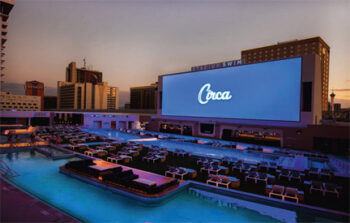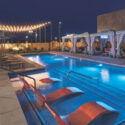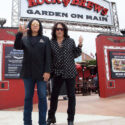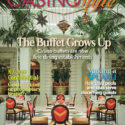
Derek Stevens was a player long before he became a casino owner. He was a manufacturer from Michigan who would make several pilgrimages to Vegas every year, mostly around sporting events, to bet on them.
“I started coming to Las Vegas a long time ago, in the ’80s” he says. “I came for pleasure. I’m a sports fan, so I came to a lot of fights and for football weekends. Forget about owning a casino; I never envisioned working at a casino.”
In 2006, though, Stevens and his brother Greg bought the Golden Gate in Downtown Las Vegas—the oldest casino in Las Vegas—and transformed it after a renovation. Five years later, Stevens bought the old Fitzgeralds casino, a few blocks up from the Golden Gate, creating the D. A few years later, he bought land behind the D and created the Downtown Events Center, an outdoor events space.
Along with Stevens, other parts of Downtown were improving. Tony Hsieh brought his Zappos headquarters to the neighborhood. Sophisticated housing was added. The Fremont Street Experience was upgraded.
“It became a really cool entrepreneurial vibe around here,” says Stevens. “Everybody had something going on. It really developed into a community of people that got to know each other and were all really aligned in a manner where everyone was rooting for the growth of Downtown Vegas.”
Soon after Stevens arrived in Downtown, the nation was hit with a deep recession. But that worked out to be in Stevens’ favor.
“Ironically, it was probably the most fortunate thing that ever happened to us,” he explains, “because, a lot of real-estate values in Downtown Las Vegas became far less expensive.”
So Stevens started assembling land across the street from the Golden Gate at the foot of Fremont Street, which is where he envisioned his perfect casino, Circa.
To design the casino, Stevens held a competition between some of the most prestigious architecture firms in gaming. Stevens paid each firm to present a concept and a preliminary design. The winner? No surprise, Steelman Partners, a firm that has put its stamp on many gaming jurisdictions.
“We competed against some very reputable architects for this project,” says Paul Steelman, the president and founder of Steelman Partners. “I think Derek chose us because we got it. We are firm believers that Las Vegas has a style, and we’re the architects who actually get that.
“We gave him the suggestions for the sportsbook, and gave him a place that looked new and modern, but it looked like it belonged on Fremont Street. And that was really important to Derek. I didn’t know how important it was to him in those competition days. But I respect Fremont Street. I started there. I lived on Fremont Street for the entire year of 1986. It was a slice of life to me. There are unusual people and unusual cars, and all types of things happening that I’d never seen in my life, growing up, and being an architect. So I think Derek chose us just because I respect it, and I believe Las Vegas has a style, now influenced by Derek Stevens.”
Sports Haven

The Circa Sports Book is part of an evolving sports betting business designed by Stevens and his team
Circa inspires the sports fan in Stevens so much that he’s built a massive sportsbook—somewhat of an anomaly in this day when most people carry sportsbooks around in their pockets as apps on their phone. But to Stevens, the sportsbook is the heart of the property.
“I have always thought in years past that a significant brick-and-mortar sportsbook was something that could bring people together,” says Stevens. “Obviously, betting on an app is not just the future; it’s the present. It’s easy, convenient and quick. It’s more efficient. But there’s still an element of going to a sportsbook, and the camaraderie with all the people, that it creates a unique excitement that you can’t get elsewhere.”
Stevens says the experience at the sportsbook at Circa will be more like a watch party rather than a pure betting play.
“I would say there’s still something inside of a Las Vegas brick-and-mortar sportsbook that’s different,” he says. “It’s not an experience they can get at Hometown USA. We’ve created a stadium effect. And for us, this isn’t really all that new. I own the Downtown Las Vegas Events Center, where we’ve been throwing concerts, EDM events, food festivals, boxing matches, UFC matches, and watch parties.
“We learned a lot in doing watch parties at our events center. The psychology of someone that goes to a watch party, it’s much different than someone that’s going to a live sporting event. It’s a different angle, a different perspective. People feel differently when they go to a watch party. There is more social demeanor as they come into the game—a little bit more upbeat and willing to socialize. We’ve really tried to create our sportsbook to be something where you end up picking up a lot of the energy of all the rest of the fans and customers who are there.”
Steelman says the placement of the sportsbook, at the back of the casino, was a debate, but one that was resolved quickly.
“The sportsbook takes up the entire Main Street side of the building,” he says. “It was a logical thing to us because, you know, the milk is at the back of the store. Same thing. Most of the foot traffic that wants to see the sportsbook has to walk through the corner of First and Fremont. So, it’s a logical thing to locate it on that side of the building.”
Parking Paradise
Parking is always an issue in Downtown Las Vegas, as it is usually in every city’s downtown. While there are lots of parking garages, they are the usual dark, dirty caverns, opening awkwardly onto the casino. Not so with Circa. The “Garage Mahal” is located across Main Street from the property, and will be a different experience than any other garage in Las Vegas.
“I’ve been talking about parking for a long, long time,” says Stevens. “I didn’t want to design an average parking garage. Parking garages are generally built with the thought of minimizing costs. You’ve got low ceilings and inadequate lighting. When you have to cut costs or reduce overtime, they stop cleaning the garage.
“We wanted to create something where the parking spaces were a little more spacious. We wanted to have great lighting. We wanted to have extreme cleanliness. We wanted to add in music. We wanted to add in art. We wanted to add in concierges throughout various areas of the garage. We feel lucky, from a design perspective, that Circa is the very first hotel-casino that I’m aware of, that ever really contemplated ride-sharing into its hotel-casino design.”
Steelman says it’s part of creating an arrival experience unmatched in all of Las Vegas.
“One of the things that we tried to do was to create a ‘wow’ experience in the lobby,” he says. “When people step from their Uber, at that moment they’d look up at the highest level of the sportsbook. You’re walking in from the garage and seeing our centerpiece. It’s quite an exciting look, and so that was part of the overall planning.”
The bridge over Main Street from Garage Mahal to the casino isn’t as elaborate as Stevens originally envisioned.
“At the end of the day, Derek, together with the Boyd Group (which owns several neighboring casinos), made a wise decision to build a very thin bridge that would allow the respect for Las Vegas that Main Street deserves. You don’t obstruct Main Street Station or the California, which need that visual aspect connecting them to Fremont Street. That led to a very good solution, and it was an interesting exercise for us, to try to make it as small as humanly possible.”
Pooling Resources
The biggest “wow” factors for Circa, however, notwithstanding the massive sportsbook and the transportation center, are the six pools on various levels on the podium of the building Stadium Swim. The pool experience is always important in a Las Vegas resort, but at Circa it’s the crucial and most visible piece of the entire building.

Circa Stadium Swim, with the second largest screen in the U.S.
But designing a pool isn’t the most simple thing. Since Las Vegas has approximately 350 sunny days a year, the way the sun would hit the pool is a very important factor. Steelman says Stevens was intimately involved in those decisions.
“We did sun studies on this pool,” he says, “and we did every day and every hour. Derek actually sat there and watched the entire movie, every day and every hour, multiple times. And it just spins around, and the sun’s going from here to there, to make sure that we weren’t making the screen too tall, or the afternoon sun in the winter would work, and things of this nature.”
Stevens says the pools are the centerpiece of the hotel, and that they are different than any other pool experience in Las Vegas.
“First is really the scale,” he says. “Stadium Swim will be a key feature in Circa Las Vegas, with a capacity of around 4,000. We have the second-largest screen in the U.S. to watch all sports, only behind the screen at AT&T Stadium in Texas. And this is a stadium to watch events and enjoy the sun. We’ll have programming that will be far more musically orientated throughout most of the day. So, as opposed to us designing a pool as an amenity for a hotel, with 512 rooms and suites, you could almost say our hotel is designed as an amenity to Stadium Swim.”
Another feature unique to Circa will be the year-round nature of the pools. Stevens says he always wondered why the pools in Vegas shut down for months at a time when the weather isn’t really that bad.
“Obviously I’d been out here Memorial Day, Fourth of July, Labor Day, you know, all throughout the summer,” he says. “But you come out in December, January, the pools are always closed. I always wondered why the pools close in Las Vegas, but they can stay open at Vail, or Park City, or Aspen. For those of you that have been out to a ski resort, whether it’s in northern Michigan or Montana or Utah or Colorado, in December and January, when it’s snowing out and 5 degrees, the pool scene’s a pretty cool scene.
“Our top pools of the upper deck, we can heat them up to 103 degrees. What we wanted to do is to create a 365-day experience, so that when people come to Circa there’s consistency that pools will be open, and yeah, temperatures are different, but we’ll create a vibe that we’ll be open every night, every day.
“Our pools won’t close. It’ll be the greatest pool in Las Vegas. It’ll be the greatest pool in America. This will be the greatest pool in the history of the world! That’s what Stadium Swim’s going to be.”
Rooms to Move
When Stevens first bought a Vegas property, it wasn’t the most modern property in the city.
“The Golden Gate is the oldest building in the history of Las Vegas,” he says. “1 Fremont Street. And when the Golden Gate was designed in 1904 or 1905, well, the average American wasn’t quite as big as what they are now. You know, the ceiling heights at the Golden Gate sometimes don’t even hit 7 feet.”
And while there were significant renovations at both the Golden Gate and the D, both properties were constrained by space. There are few suites in either hotel. But that’s not the case with Circa.
“We’re going to be heavily weighted on suites,” says Stevens. “We’re going to open with 777 rooms and 60 suites—six two-bedrooms and the rest will be one bedroom. We’ll have a handful of hospitality suites and some bunk rooms, party suites and things like that. We think there’s a certain element where when you have big groups that come out, we’ll let them sleep in a bunk room, but they’ll have a huge living room out front, with a bar, and TVs and couches. We’re excited about this room product, and we’re excited about having far more suites in our mix.
“We’ve done something with design, with much taller ceilings, with much more spacious showers and bathrooms—much taller showerheads, and things like that.”
Even the standard rooms are something special, say Stevens.
“Our average square footage is 450 or 460 square feet,” he says. “We did something from a design perspective—we ran an offset hallway. Our tower runs west to east, and our hallway’s not straight down the middle of the tower. It’s shaded by about 20 inches to the north, which provides for standard rooms that are a little bit larger to the south than the north. The south, on the lower part of the tower, faces Stadium Swim. And the south on the higher part of the tower gives you the Strip views. We think the rooms are ready for today’s customer, and ready to last for a while.”
Steelman says a lot of other elements went into the tower.
“We wanted a short walk to the rooms,” he says. “We want the elevators to be designated to the customer. We believe in creating not only stratified hotel rooms, or stratified hotel floors on the basis of suites and standard rooms, but also then, those elevators engaging in the podium in the proper sort of way.”
But when you get to the top of the tower, that’s where Circa really shines.
“I think we have captured a view that nobody has,” says Steelman. “I think the view from the Legacy Club on the roof is probably one of the most spectacular views in Las Vegas. I always thought the Stratosphere had a spectacular view, but seeing the Stratosphere from this 400-plus-foot-tall building really empowered us.”
Covid Conscious
When casinos closed in Las Vegas on March 18 and didn’t reopen until June 4, Stevens put procedures in place at his casinos over and above what lots of other casinos have done. At the D, as of September, guests were required to get temperature checks, walk through a metal detector and wear masks. He says the same will go into effect at Circa should the same restrictions be in place.
“All we can really do as operators is continue to follow all the guidelines, all the directives,” he says. “Of course we have to do that. Gaming is a privileged license.
“But we just have to be prepared to adapt quickly. When we reopened, we did something above and beyond, temperature checks at our doors. The regulation is you have to do a temperature check to go to a hotel room. So we temperature-checked everyone coming in and out. We thought that gave people a sense of greater security. We also felt that it was a safer thing to do.”
With some disturbances occurring on the Las Vegas Strip, Stevens says his casinos strive to keep the guests safe and secure by requiring ID to enter.
“From a security perspective, I think everyone has been adapting as best they can. Our country just wasn’t necessarily ready for the magnitude of what happened, and I think because of the magnitude, everyone in the country is struggling, some from a health perspective, some from a financial perspective, some from a general economic perspective, some from just an isolation and psychological perspective. We hope they can visit us in Las Vegas and give them some relief.”
Legend in the Making
 Lots of people compare Derek Stevens to the visionary Steve Wynn in his early days, when he was full of ideas, entrepreneurial fire and operational magic. Steelman agrees.
Lots of people compare Derek Stevens to the visionary Steve Wynn in his early days, when he was full of ideas, entrepreneurial fire and operational magic. Steelman agrees.
“We have a superstar in the making in Derek Stevens,” he says. “Derek’s vision on this property is unlike anyone else’s. Circa has a unique spin to it.
“When I have my foreign clients here from Vietnam, Cambodia or Macau, or some even from Atlantic City, many times, we go down to Andiamo’s (the Italian restaurant in the D) for dinner, because it’s got a great old Las Vegas feeling. And then we walk up Fremont Street, and they all turn to me and say, ‘Paul, we want this.’ Here’s a little tiny street in Downtown Las Vegas that attracts 24 million people each and every year, and it still resonates. So, one of our unique challenges on this design—and Derek’s challenge, of course—was to design, from the ground up, a facility that was compatible with Fremont Street. And we’ve done that without a doubt.”
Stevens is a little more demure when it comes to his legacy.
“I love operating casinos,” he says. “I love building teams. I like being around our people. I don’t love being a deal-maker. You know, I kind of got thrown into that. I’m not going to back off from numbers or finance, but I don’t love it the way I love teams and love growing businesses. For me, coming here from 2006, with the Golden Gate, to 2011 at the D, and 2014 with the Events Center, I now have a great opportunity to be with a lot more great people that we work with and our guests. And for that, I’m very grateful.
“I am beyond excited to be able to operate and run Circa, for the first year. We have the first 365 days numerically mapped out. I look forward to operating that way. And then, day 366 to day 730, I can’t wait to see what the second March Madness is going to be like, and the second St. Patrick’s Day, and the second Fourth of July. Because that gives us an opportunity to get better. That’s the stuff that gets me all fired up. When we open, we’re going to have fun, but we always have to get better.”










